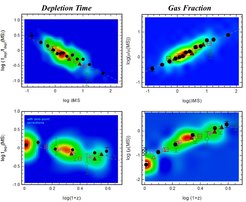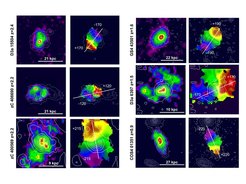News and Recent Results of the MPE Infrared/Submillimeter Group
Outflow Demographics and Physical Properties at z ~ 1–3
July 2018
Exploiting our full KMOS3D and SINS/zC-SINF surveys of near-IR IFU spectroscopy of z ~ 1–3 galaxies, we obtained the most complete census to date of galactic-scale ionized gas outflows at the peak epoch of cosmic star formation and AGN activity. The sample of ~ 600 primarily mass-selected galaxies spans wide ranges in stellar mass and star formation rate; the selection by mass, rather than by properties biased toward star formation (SF) or AGN activity, makes it ideally suited for a population-averaged characterization of winds as relevant to galaxy evolution. Compared to slit spectra, the IFU data greatly facilitate the separation between the broad outflow component in Hα+[NII]+[SII] and the narrower component from SF. Our studies show how outflows driven by SF and AGN are spatially, spectrally, and demographically distinct. SF-driven winds, launched near bright star-forming clumps across disks, have typical speeds of ~ 450 km/s below the hosts’ escape velocity except at log(M⁎/M☉) < 10.3; the prevalence of these winds depends on SF properties, not mass. AGN-driven winds originate from the nuclear regions, are ubiquitous in log(M⁎/M☉) > 10.7 galaxies hosting a massive bulge but rare at lower masses, irrespective of SF activity; with velocities of ~ 1,500 km/s, they can escape the galaxies. For the first time, the high S/N spectra constrain the density in high-z SF-driven winds from the broad [SII] doublet ratio, yielding ne ~ 400 cm-3; for AGN-driven winds, a higher ne ~ 1,000 cm-3 is inferred. These densities are a factor of several higher than previously assumed values, and lead to correspondingly more modest mass outflow rates ~ 0.1–0.4 x SFRs in warm ionized gas. The tension with theoretical work, requiring mass outflow rates ≳ SFRs to reproduce the observed relationships between galaxy mass and metallicity as well as galaxy mass and halo mass at log(M⁎/M☉) < 10.7, could be alleviated if substantial mass, momentum, and energy were ejected in hotter and/or colder phases than the ~ 104 K ionized gas probed by our data. The fast, high-duty-cycle AGN-driven winds at high masses carry significant energy (~ 1% that of the AGN), which may contribute to heat halo gas and help prevent further gas infall. Our results are consistent with recent EAGLE and Illustris/TNG numerical simulations, which suggest that such a mechanism, acting also at the modest luminosities and Eddington ratios of the majority of the KMOS3D and SINS/zC-SINF AGN, may be more effective at widespread and long-term quenching than ejective "QSO mode" feedback in rare, high-luminosity, high-Eddington-ratio AGN.
![These images show the spatial distribution, spectral properties, and demographics of SF- and AGN-driven galactic winds (top and bottom rows). From left to right: maps of two example galaxies from SINFONI+AO and HST (FWHM physical resolution of ~ 1.8 kiloparsecs), composite spectra from our KMOS3D and SINS/zC-SINF samples, and the fraction of galaxies exhibiting the broad Hα+[NII]+[SII] outflow signature as a function of galaxy stellar mass and offset in SFR relative to the main-sequence relationship.](/7230638/original-1623223849.jpg?t=eyJ3aWR0aCI6MjQ2LCJvYmpfaWQiOjcyMzA2Mzh9--5ff37fc67c937bb0dc551bad80eef5f509277c21)
These images show the spatial distribution, spectral properties, and demographics of SF- and AGN-driven galactic winds (top and bottom rows). From left to right: maps of two example galaxies from SINFONI+AO and HST (FWHM physical resolution of ~ 1.8 kiloparsecs), composite spectra from our KMOS3D and SINS/zC-SINF samples, and the fraction of galaxies exhibiting the broad Hα+[NII]+[SII] outflow signature as a function of galaxy stellar mass and offset in SFR relative to the main-sequence relationship.
More information: Research paper: Förster Schreiber, Übler, Davies et al. 2019, ApJ, 875, 21
Scaling Relations for Molecular Gas in Galaxies over Cosmic Time
February 2018
We have developed new statistically robust scaling relations between galaxy-integrated molecular gas masses, stellar masses, and star formation rates (SFRs) relative to that on the main sequence (δMS). Combining data from our PHIBSS and xCOLDGASS surveys with information available in literature, we use three independent methods to determine molecular gas masses: 1) CO line fluxes, 2) Herschel far-infrared dust SEDs, and 3) ~ 1 mm dust photometry, in a large sample of 1,444 star-forming galaxies and stacks between z = 0 and 4. The sample spans stellar masses from log(M⁎/M☉) = 9.0–11.8, and SFRs relative to that on the MS, from 10-1.3 to 102.2. The most important result is that all data sets follow the same scaling trends, once we account for uncertainties and apply consistent methodologies. The molecular gas depletion time tdepl, defined molecular gas mass/star formation rate, scales as (1+z)-0.6 x (δMS)-0.44, and is only weakly dependent on stellar mass. The ratio of molecular to stellar mass μgas depends on (1+z)2.5 x (δMS)0.52 x (M⁎)-0.36, and tracks the evolution of the specific SFR.

These images show the scaling of tdepl (left) and μgas = Mmolgas/M⁎ (right) with redshift (bottom) and SFR relative to that on the main sequence, δMS (top). The colors illustrate the overall distribution of our data, and the large symbols are binned averages for the different gas mass determination methods (CO: black circles, dust SEDs: unfilled symbols, submm continuum: brown filled triangles). The dashed lines are the best global, multiparameter fits to the data.
More information:
- Research paper: Tacconi et al. 2018 ApJ 853, 179
- Research paper: Genzel et al. 2015 ApJ 800, 20
- Research paper: Tacconi et al. 2013 ApJ 768, 74
Strongly Baryon-dominated Disk Galaxies at the Peak Epoch of Galaxy Formation
March 2017

New observations of rotating galaxies at z ~ 2, the peak epoch of galaxy formation, show that these massive star-forming galaxies are strongly dominated by baryonic mass, with dark matter playing a much smaller role in comparable regions of their outer disks than in typical present-day spiral galaxies. This result was obtained from observations of unprecedented sensitivity with the SINFONI and KMOS near-IR integral field spectrometers, mapping the 2D kinematics of ionized gas through the Hα line emission of six galaxies out to two to three times their half-light radius. On these scales, dark matter starts to dominate the total mass budget in z ~ 0 late-type galaxies, causing their rotation curves to stay mostly flat or slightly increase with radius. In contrast, the six individual massive z ~ 2 galaxies in our study exhibit declining rotation curves, which can be explained by the combination of two factors: baryons dominate more strongly than dark matter on galactic scales, and the elevated gas turbulence characteristic of z ~ 2 disks provides a significant amount of the dynamical support, thereby leading to a decrease in the rotation velocity. Such a falloff with radius is further seen in the average outer rotation curve derived through a novel stacking technique of ~ 100 typical massive z ~ 1–2.5 disk galaxies observed with KMOS and SINFONI, suggesting that it is a common feature among the star-forming population in these epochs. Two additional studies of the resolved inner disk kinematics (out to 1–1.5 half-light radius or the velocity turnover radius) of 240 star-forming disks support the results based on the outer rotation curves. Detailed dynamical modeling shows that while the stars and gas account on average for ~ 56% of the total enclosed mass at z ~ 1–2.5, the baryon fraction reaches ~ 90% at the higher redshifts, and is largest in disks with highest central baryonic mass surface density. The evolution of the zero point of the stellar and baryonic Tully-Fisher relationships based on the same data is further compatible with the increase in gas and baryon mass fractions with redshift, with a lesser role of dark matter in the central disk regions. The low-galactic-scale dark matter fractions found in massive high-redshift galaxies in these studies are comparable to those of present-day massive early-type galaxies, their likely descendants. The high gas fractions in z ~ 2 star-forming galaxies could help to dissipate angular momentum, efficiently driving gas inward and leading to the strong dominance of baryons early on.

More information:
- MPE press release
- Research paper: Genzel et al. 2017, Nature, 543, 397
- Research paper: Lang et al. 2017, ApJ, 840, 92
- Research paper: Übler et al. 2017, ApJ, 842, 121
- Research paper: Wuyts et al. 2016, ApJ, 831, 149
![These images show the spatial distribution, spectral properties, and demographics of SF- and AGN-driven galactic winds (top and bottom rows). From left to right: maps of two example galaxies from SINFONI+AO and HST (FWHM physical resolution of ~ 1.8 kiloparsecs), composite spectra from our KMOS3D and SINS/zC-SINF samples, and the fraction of galaxies exhibiting the broad Hα+[NII]+[SII] outflow signature as a function of galaxy stellar mass and offset in SFR relative to the main-sequence relationship. These images show the spatial distribution, spectral properties, and demographics of SF- and AGN-driven galactic winds (top and bottom rows). From left to right: maps of two example galaxies from SINFONI+AO and HST (FWHM physical resolution of ~ 1.8 kiloparsecs), composite spectra from our KMOS3D and SINS/zC-SINF samples, and the fraction of galaxies exhibiting the broad Hα+[NII]+[SII] outflow signature as a function of galaxy stellar mass and offset in SFR relative to the main-sequence relationship.](/7230638/original-1623223849.jpg?t=eyJ3aWR0aCI6ODQ4LCJmaWxlX2V4dGVuc2lvbiI6ImpwZyIsIm9ial9pZCI6NzIzMDYzOH0%3D--471b413d350050974867edfc5faa4fb0f648edbe)


